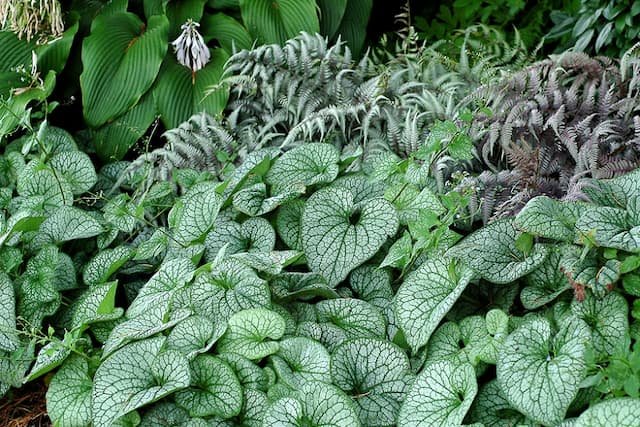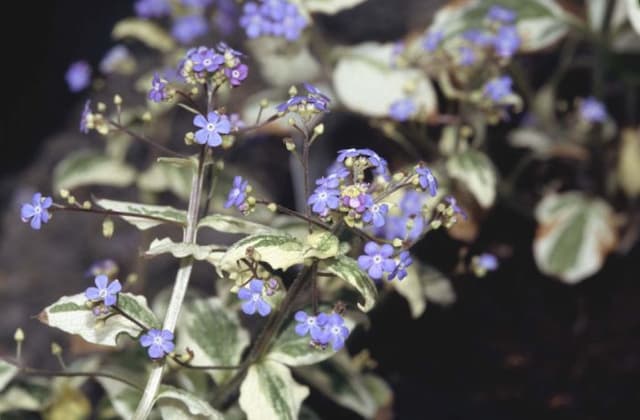Lungwort Pulmonaria 'Lewis Palmer'

ABOUT
The Pulmonaria 'Lewis Palmer', also commonly known as lungwort, is a herbaceous perennial plant renowned for its decorative foliage and springtime blooms. It has a basal rosette of leaves that are distinctively mottled with patterns of silver and green, giving them a speckled or marbled appearance. The leaves are generally oval to lance-shaped with a rough, hairy texture that can feel slightly prickly to the touch. The charm of lungwort additionally lies in its flowers, which bloom in clusters on short, upright stems above the foliage. These blossoms are tubular and change color as they age, typically starting out a pinkish or reddish hue and transitioning to a vivid blue or violet. This enchanting dual-color display provides a unique characteristic where the plant has multicolored blooms at any given time during its flowering phase, creating a delightful contrast against the variegated leaves. As the plant matures through the seasons, the patterns on the leaves may become more silver, especially as the intensity of the light hitting them changes. The overall impression of the lungwort is one of a vibrant and texturally rich plant that adds both color and visual interest to shaded garden spaces or woodland settings. The combination of its exquisite leaves and dynamic blooms make it a popular choice for gardeners looking to enhance their landscape with plants that offer multiple seasons of ornamental appeal.
About this plant
 Names
NamesFamily
Boraginaceae
Synonyms
Lungwort, Bethlehem Sage, Jerusalem Cowslip
Common names
Pulmonaria angustifolia 'Lewis Palmer', Pulmonaria officinalis 'Lewis Palmer'.
 Toxicity
ToxicityTo humans
Lungwort, including the cultivar 'Lewis Palmer', is generally considered non-toxic to humans. There are no well-documented cases of poisoning from ingesting lungwort. Consequently, accidental ingestion is unlikely to cause harm, but as with any plant, individual allergies or sensitivities may exist, so it is advisable to avoid consuming this plant without proper knowledge of its effects.
To pets
Lungwort, including the 'Lewis Palmer' variety, is not known to be toxic to pets. It is generally considered safe around animals, and there should not be any significant risk if a pet happens to ingest some of the plant. As with humans, individual animals can have allergies or sensitivities, so monitoring for any unusual reactions and consulting a veterinarian if concerns arise would be prudent.
 Characteristics
CharacteristicsLife cycle
Perennials
Foliage type
Semi-deciduous
Color of leaves
Mixed
Flower color
Blue
Height
1 foot (30 cm)
Spread
1-2 feet (30-60 cm)
Plant type
Herb
Hardiness zones
4
Native area
Europe
Benefits
 General Benefits
General Benefits- Attracts Pollinators: Pulmonaria 'Lewis Palmer' is known to attract bees and butterflies, which are essential for pollination.
- Shade Tolerance: It thrives in shady areas where other plants might struggle, making it ideal for woodland gardens or shaded borders.
- Ornamental Foliage: The plant has spotted or variegated leaves that add visual interest to the garden even when it's not in bloom.
- Spring Blooms: It produces clusters of blue to violet flowers in early spring, providing an early source of nectar for insects and adding color to the garden after winter.
- Ground Cover: Due to its spreading habit, it can be used as an effective ground cover, reducing weed growth and soil erosion.
- Drought Resistance: Once established, Pulmonaria 'Lewis Palmer' is relatively drought-tolerant, requiring less frequent watering.
- Low Maintenance: This plant does not require extensive care, making it a good choice for gardeners of all skill levels.
- Hardiness: It is resilient in a range of hardiness zones, usually from zone 3 to 8, which means it can withstand cold winters.
- Deer Resistance: Pulmonaria 'Lewis Palmer' is not a favorite of deer, so it's less likely to be damaged by browsing animals.
 Medical Properties
Medical PropertiesThis plant is not used for medical purposes.
 Air-purifying Qualities
Air-purifying QualitiesThis plant is not specifically known for air purifying qualities.
 Other Uses
Other Uses- Pulmonaria 'Lewis Palmer' can be used as a natural dye for fabrics, where the leaves may impart a light green hue.
- The plant's mucilaginous leaves can be used to soothe burns or insect stings, similar to how aloe vera is utilized.
- Gardeners often plant Pulmonaria 'Lewis Palmer' to attract pollinators like bees and butterflies, thus supporting local ecosystems.
- The fallen leaves of the Lungwort can be left in situ to decompose and act as a natural mulch, providing nutrients back to the soil.
- Pulmonaria 'Lewis Palmer' can be used in a 'moon garden' due to its silver-spotted foliage that reflects the moonlight, enhancing nighttime garden aesthetics.
- The leaves can be incorporated into compost piles, as they are rich in nitrogen and break down easily, enriching the compost mix.
- As an edging plant, Pulmonaria 'Lewis Palmer' can be used to define garden paths and borders due to its clump-forming habit.
- In a sensory garden, the textured leaves of the Lungwort can provide a tactile experience for visitors.
- The plant can be used in cut flower arrangements when in bloom, offering a unique spotted foliage and clusters of flowers that can last several days in water.
- Lungwort's dense foliage can offer a hiding place for small garden creatures, such as frogs and beneficial insects, providing them with shelter.
Interesting Facts
 Feng Shui
Feng ShuiThe Lungwort is not used in Feng Shui practice.
 Zodiac Sign Compitability
Zodiac Sign CompitabilityThe Lungwort is not used in astrology practice.
 Plant Symbolism
Plant Symbolism- Hope: Pulmonaria, commonly known as Lungwort, often symbolizes hope due to its early spring bloom, signaling the end of winter and the arrival of new life.
- Health and Wellness: Historically, Lungwort was used in herbal medicine, particularly for treating lung diseases, which is reflected in its symbolic association with good health and healing.
- Longevity: The plant's resilience and ability to thrive in shade can be seen as a symbol of longevity and endurance.
 Water
WaterThe Lungwort 'Lewis Palmer' requires consistent moisture, so water it deeply once a week with approximately 1 gallon of water, ensuring the soil stays moist but not waterlogged. During hot, dry spells this may need to be increased to twice per week to maintain soil moisture. Always check the top inch of soil for dryness before watering, and reduce frequency in the winter when the plant is not actively growing.
 Light
LightLungwort 'Lewis Palmer' thrives in partial shade to full shade conditions. It is best positioned in a spot where it receives filtered sunlight or morning sun followed by afternoon shade. Avoid placing it in full sun, as the leaves can burn and the plant may not produce as many blooms.
 Temperature
TemperatureLungwort 'Lewis Palmer' prefers cooler temperatures and will grow well in temperatures between 50 to 75 degrees Fahrenheit. It can tolerate temperatures as low as 20 degrees Fahrenheit in the winter but may suffer if the temperature rises above 80 degrees Fahrenheit, especially if it is also exposed to direct sunlight.
 Pruning
PruningLungwort 'Lewis Palmer' should be pruned to remove old, damaged, or diseased foliage and to promote healthier growth. The best time for pruning is immediately after flowering, typically in late spring or early summer. Pruning can be done yearly to maintain a tidy appearance and encourage a flush of fresh leaves.
 Cleaning
CleaningAs needed
 Soil
SoilLungwort 'Lewis Palmer' thrives in moist, well-draining soil rich in organic matter, with a pH range of 6.0 to 7.5. A mix of garden soil, compost, and a bit of perlite or sand can create an ideal environment for this shade-loving perennial.
 Repotting
RepottingLungwort 'Lewis Palmer' does not require frequent repotting and can be done every 2-3 years or when the plant outgrows its container. Spring is the best time to repot to minimize stress on the plant.
 Humidity & Misting
Humidity & MistingLungwort 'Lewis Palmer' prefers a humid environment, similar to its natural woodland habitat. Aim for humidity levels around 50% for optimal growth, but the plant is somewhat tolerant if the air is not excessively dry.
 Suitable locations
Suitable locationsIndoor
Place Lungwort in a shady spot with indirect sunlight.
Outdoor
Plant in shaded area; well-draining, moist soil.
Hardiness zone
3-8 USDA
 Life cycle
Life cyclePulmonaria 'Lewis Palmer', commonly known as lungwort, begins its life when seeds are sown in moist, well-drained soil in early spring or after the last frost. The seeds germinate, and the young seedlings emerge, developing a rosette of basal leaves. As the plant matures, it enters the vegetative growth stage, producing distinctive silver-spotted, green foliage. In spring, the lungwort progresses to its flowering stage, showcasing clusters of blue, violet, pink, or white flowers which are attractive to pollinators. After pollination, the flowers fade, and the plant sets seed, completing its reproductive cycle. During the winter or in unfavorable conditions, lungwort may enter dormancy, with foliage dying back, to re-emerge and restart the growth cycle when conditions improve.
 Propogation
PropogationPropogation time
Spring-Early Summer
The Pulmonaria 'Lewis Palmer', commonly known as Lungwort, is frequently propagated in the spring or early summer through division. This popular method involves carefully digging up an established clump of the plant once the flowers have faded and the foliage has started to mature. Using a sharp, sanitized spade or knife, the clump is then gently divided into smaller sections, each with a decent amount of roots and several shoots. These sections should be immediately replanted in moist, well-draining soil, ideally in partial shade to mimic the plant's favored growing conditions. Water the new divisions well, providing about an inch (2.54 cm) of water per week to ensure proper establishment. Notably, division not only helps propagate the plant but also invigorates older clumps which might have become woody or less vigorous at the center.









